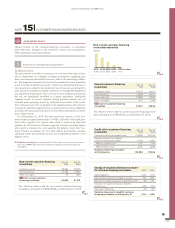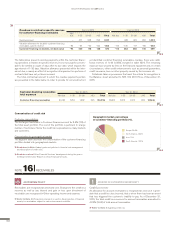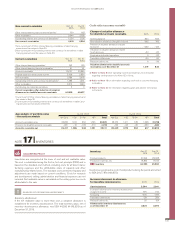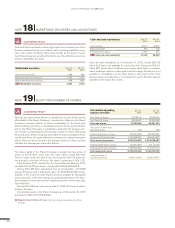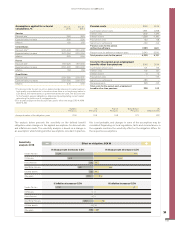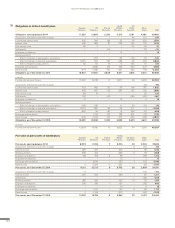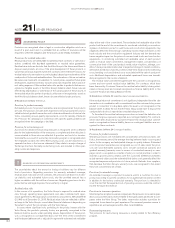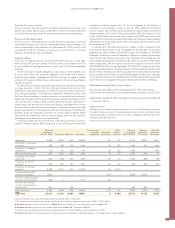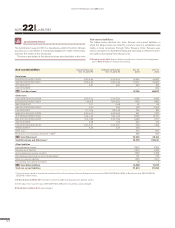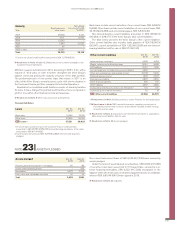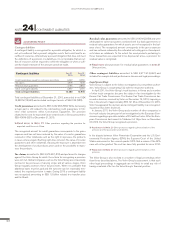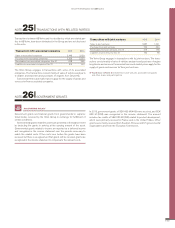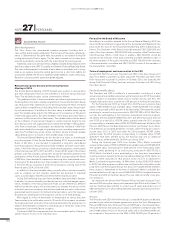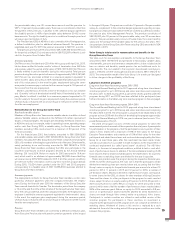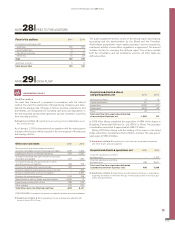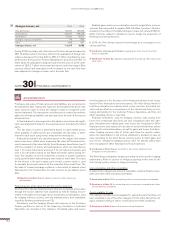Volvo 2015 Annual Report Download - page 146
Download and view the complete annual report
Please find page 146 of the 2015 Volvo annual report below. You can navigate through the pages in the report by either clicking on the pages listed below, or by using the keyword search tool below to find specific information within the annual report.
144
GROUP PERFORMANCE 2015 NOTES
Provisions are recognized when a legal or constructive obligation exists as a
result of a past event and it is probable that an outflow of resources will be
required to settle the obligation and the amount can be reliably estimated.
Provisions for residual value risks
Residual value risks are attributable to operating lease contracts or sales trans-
actions combined with buy-back agreements or residual value guarantees.
Residual value risks are the risks that the Volvo Group in the future would have to
dispose used products at a loss if the price development of these products is
worse than what was expected when the contracts were entered. Provisions for
residual value risks are made on a continuing basis based upon estimations of the
used products’ future net realizable values. The estimations of future net realiza-
ble values are made with consideration to current prices, expected future price
development, expected inventory turnover period and expected direct and indi-
rect selling expenses. If the residual value risks pertain to products that are rec-
ognized as tangible assets in the Volvo Group’s balance sheet, these risks are
reflected by depreciation or write-down of the carrying value of these assets. If
the residual value risks pertain to products, which are not recognized as assets in
the Volvo Group’s balance sheet, these risks are reflected under provisions.
Read more in Note 7 Revenue.
Provision for product warranty
Estimated provision for product warranties are recognized when the products
are sold. The provision includes both expected contractual warranties and so
called technical goodwill warranties and is determined based on historical sta-
tistics considering known quality improvements, costs for remedy of defaults
etc. Provision for campaigns in connection with specific quality problems are
recognized when the campaign is decided.
Provision for restructuring costs
A provision for decided restructuring measures is recognized when a detailed
plan for the implementation of the measures is complete and when this plan is
communicated to those who are affected. A provision and costs for termina-
tion benefits as a result of a voluntary termination program is recognized when
the employee accepts the offer. Restructuring costs can be reported as a
separate line item in the income statement if they relate to a major change of
the Group structure. Normally restructuring costs are included in other oper-
ating income and expenses.
ACCOUNTING POLICY
NOTE 21 OTHER PROVISIONS
SOURCES OF ESTIMATION UNCERTAINTY
!
The uncertainties about the amount or timing of outflows vary for different
kind of provisions. Regarding provisions for warranty, extended coverage,
residual value risks and service contracts, the provisions are based on histori-
cal statistics and estimated future costs, why the provided amount has a
higher correlation with the outflow of resources. Regarding provisions for dis-
putes, like tax and legal disputes, the uncertainty is higher.
Residual value risks
In the course of its operations, the Volvo Group is exposed to residual value
risks through operating lease agreements and sales combined with repur-
chase agreements. Residual value commitments amounted to SEK 22,585 M
(21,146) as of December 31, 2015. Residual value risks are reflected indiffer-
ent ways in the Volvo Group’s consolidated financial statements depending on
the extent to which the risk remains with the Volvo Group.
In cases where significant risks pertaining to the product remain with the
Volvo Group, the products, primarily trucks, are generally recognized in the
balance sheet as assets under operating leases. Depreciation of these prod-
ucts is recognized on a straight-line basis over the term of the commitment
and the depreciable amount is adjusted to agree with estimated net realizable
value at the end of the commitment. The estimated net realizable value of the
products at the end of the commitment is monitored individually on a continu-
ing basis. A decline in prices for used trucks and construction equipments may
negatively affect the Volvo Group’s operating in come. High inventories in the
truck industry and the construction equipment industry and low demand may
have a negative impact on the prices of new and used trucks and construction
equipments. In monitoring estimated net realizable value of each product
under a residual value commitment, management makes considerations of
current price-level of the used product model, value of options, mileage, con-
dition, future price deterioration due to expected change of market conditions,
alternative distribution channels, inventory lead-time, repair and reconditioning
costs, handling costs and indirect costs associated with the sale of used prod-
ucts. Additional depreciations and estimated impairment losses are immedi-
ately recognized in the income statement.
The residual value commitment agreed with the customer is recognized as
current and non-current residual value liabilities. For contracts which have
been financed by Customer Finance the residual value liability is being elimi-
nated on Group level and instead recognized as finance liability both in the
Customer Finance and Group Balance Sheet.
Read more in Note 22 Liabilities about residual value liabilities.
If the residual value risk commitment is not significant, independent from the sale
transaction or in combination with a commitment from the customer to buy a new
product in connection to a buy-back option, the asset is not recognized on the
balance-sheet. Instead, the risk that the Volvo Group would have to dispose the
used products at a loss is reported as a residual value provision.
To the extent the residual value exposure does not meet the definition of a
provision, the gross exposure is reported as a contingent liability. For contracts
which have been financed by Customer Finance the residual value commit-
ment is recognized as finance liability, hence no contingent liabilities are rec-
ognized for these contracts.
Read more in Note 24 Contingent liabilities.
Provision for product warranty
Warranty provisions are estimated with consideration of historical claims sta-
tistics, the warranty period, the average time-lag between faults occurring and
claims to the company and anticipated changes in quality indexes. Estimated
costs for product warranties are recognized as cost of sales when the prod-
ucts are sold. Estimated warranty costs include contractual warranty and
goodwill warranty (warranty cover in excess of contractual warranty or cam-
paigns which is accepted as a matter of policy or normal practice in order to
maintain a good business relation with the customer). Differences between
actual warranty claims and the estimated final claims cost generally affect the
recognized expense and provisions in future periods. Re funds from suppliers,
that decrease the Volvo Group’s warranty costs, are recognized to the extent
these are considered to be certain.
Provisions for extended coverage
An extended coverage is a product insurance sold to a customer to cover a
product according to specific conditions for an agreed period and/or content
in addition to the factory contractual warranty. The provision is intended to
cover the risk that the expected cost of providing services under the contract
exceed the expected revenue.
Provisions in insurance operations
Volvo Group has a captive insurance company and the provisions in insurance oper-
ations consist of the claims reserve related to third party claims addressed to com-
panies within the Volvo Group. The claims reserve also includes a provision for
unreported losses based on past experience. The unearned premium reserve is
reported as an accrued expense within other current liabilities.
Restructuring measures
The provision for restructuring measures is mainly related to the efficiency
program.



